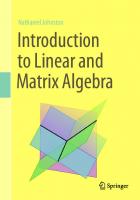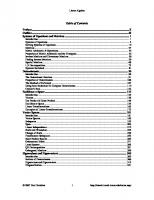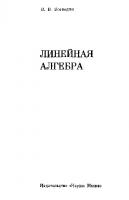Introduction to Linear Algebra 0030782007, 9780030782008
136 91 23MB
English Pages 388 [408] Year 1970
Preface,
chapter
chapter
chapter
1. FUNDAMENTAL
MATHEMATICAL CONCEPTS
1.1 Logic
1
1.2 Sets
8
1.3 Functions
15
1.4 Operations
29
1.5 Homomorphisms
39
1.6 The Real Number System
49
VECTOR SPACES
2.1 A Generalization of R
55
2.2 Vector Spaces
63
2.3 Subspaces
73
2.4 Dependence
85
2.5 Independence and Rases
91
2.6 Dimension
96
2.7 Completing a Rasis
104
2.8 Ordered Rases and Coordinates
109
3. LINEAR
TRANSFORMATIONS AND MATRICES
3.1 Linear Transformations 116
3.2 Rank of a Linear Transformation 124
Xll
Contents
3.3 Nonsingular Linear Transformations 129
3.4 Systems of Linear Transformations 137
3.5 Matrix of a Linear Transformation 145
3.6 Systems of Matrices 155.
3.7 Matrix Manipulations 169
3.8 Matrices and Coordinates 181
3.9 Rank of a Matrix 186
chapter 4. LINEAR
EQUATIONS AND DETERMINANTS
4.1 Equivalent Systems of Linear Equations 195
4.2 Homogeneous and Nonhomogeneous Systems 200
4.3 Elementary Matrices 209
4.4 Some Computational Techniques 220
4.5 Determinants 228
4.6 Inversion via Adjoint; Cramer’s Rule 243
chapter 5. CHANGING BASES
5.1 Row Equivalence Revisited 251
5.2 Column Equivalence; Equivalence 258
5.3 Similarity 270
5.4 Eigenvectors, Eigenvalues, and the
Characteristic Equation 278
5.5 Distinct Eigenvalues 287
chapter 6. EUCLIDEAN SPACES
6.1 R2 and the Dot Product 297
6.2 R3Dot and Cross Products 309
6.3 Euclidean Spaces 318
6.4 Orthogonal Vectors 324
6.5 Orthogonal Transformations 336
Answers to Problems, 347
List of Symbols, 383
Index, 385
Recommend Papers

- Author / Uploaded
- Eugene F. Krause
File loading please wait...
Citation preview
ntroduction to
■;;:-.1 _ v,
.•:'
*»V % 'g*0 :• :*..•;.. -'•• .;• •
:
, . _•
. .*
•, '*«•'• ■».• t. * .*>•
• -.•
| '-C. '•Mi&i';\
,"'.V-r::-*. •".,; ■ v
*&# .V.
i
I//;;*?
E«-': ■ * \ -\ C
• ‘j/l
•'.'fV-'IU'-'v. ..
’’ ":- ■
* '
'. V •
1
; '.'■I,.
^r-i^ ;.S,\ , • .
• V, ‘ 5->;$
‘lT » >*
-“■’.. " >V '-,' ■
■:
'
1 '• v..V'4'ie ■< . -- il•
mm
v ;.':i.
-
'
'■■
I• '■> 5 -
,', bt’ft'jS);
>
'
'i ‘-:
*J'
'
' ' ’»(s v r.,- -
: £V.
.
psiiis ■v ■ ■ UvsSc
. ■ .•;jr> • •••
>• -»>
!
v-
*vV('-
V?^hv:
'•
‘-'«V SJ? k»^->
I'5:
: ■;
;|-y'
•
'
.
,.
.
"
3
**': i,> '*
8
' ■.' ',;'• I
■y'-Y-'h-'' , ■,
:•'■;■'—■■ ;. ■ ;\’v-;¥;/¥
"■-
'r
■ ±' *■:■'-■ '-V> ■ -• \
v'l-'»*lfi, «.Vi'S
M .V-.C\Y•''■ John is my friend.” “Water freezes if and only if the temperature is below 32°F.” becomes “Water freezes
the temperature is below 32°F.”
1.1
Logic
3
As we prove theorems, we shall often use the method of indirect, or contrapositive, proof. For example, suppose we wish to prove that all Armenians like shish kebab. The direct way to do it would be to round up all Armenians and determine that each one likes shish kebab. The indirect way would be to round up all people who do not like shish kebab and check that there be no Armenians among them. That is, we could prove the implication x is an Armenian => x likes shish kebab by proving its contrapositive x does not like shish kebab => x is not an Armenian. Symbolically,
(A => B) (not B => not A)
where A and B are statements. To use this method of proof one must know how to negate, or deny, a variety of statements. Denying an atomic, or indecomposable, state¬ ment is trivial. To deny “He is present” is to affirm “He is absent.” To deny “x < 3” is to affirm “x > 3.” Denying statements involving “and,” “or,” “not,” V, 3, =>, is more complicated.
EXAMPLE 1.1.3 i.
The negation (denial) of “I am hot and I am tired” is “I am not hot or1 I am not tired.” Thus to deny that I am hot and tired is to affirm that I am not hot or I am not tired. Symbolically,
not (A and B) ^ (not A) or (not B).
ii.
The negation of “The meeting is on Tuesday or it is on Wednesday” is “The meeting is not on Tuesday and it is not on Wednesday.” Symbolically,
not (A or B) B) A and (not B).
v.
The negation of “Everyone is honest” is “There is at least one dis¬ honest person.” Symbolically, if P(x) denotes a property of x such as “x is honest,”
not VxP(x) lx not P(x).
vi.
fc
:
The negation of “There is a fly in my soup” is “Every fly is not in my soup.” Symbolically,
not 3xP(x) Vx not P(x).
The negation of “if and only if” statements is left as Problem 1.1.11. These symbolic rules for negation should not strike you as new or strange. They are merely compact summaries of the ordinary logic you are accustomed to using. In most situations your common sense will serve you better than will memorized rules. In complicated situations, however, reference to these rules can prove useful.
EXAMPLE 1.1.4 In calculus the definition of “/ is continuous at 5” is essentially as follows: Ve {e > 0 => 3 0 => 38[8 > 0 and Vx(\x — 5| < 8 => \f(x) — /(5)| < e)]} «=> 3e not {e > 0 => 36[5 > 0 and Vx{\x — 5| < 5 => | f(x) — /(5)| < «)]} 0 and not 3 |fix) — /(5)| < e)]} 3e {e !> 0 and W8 not [8 > 0 and N/:r(|:r 5j \f(x) /(o) | 0 and V5 [not 8 > 0 or not Vx(\x — 5| < 8 => If(x) - /(5)| 0 and V5[ 0 and W 8[8 < 0or3x(|x - 5| < 5 and\f(x) - /(5)| > e)]}. In words, / is discontinuous at 5 if and only if there is a positive number e such that for every positive number 5 there is some number x within 5 of 5 for which f(x) differs from /(5) by at least €. (See Problem L1.4.C.)
EXAMPLE 1.1.5 To deny the statement, “All Armenians like shish kebab or I am a monkey's uncle," one can introduce symbols for the atomic statements: A(x): x is an Armenian, S(x): x likes shish kebab, U: I am a monkey's uncle. Then translate the original statement into symbols: Wx[A(x) => S(x)] or U, and deny the symbolic statement using the symbolic rules for negation: not {Vx[A(x) => S(x)] or U] not Vx[A(a:) => $(#)] and not U 3x not [A(x) => S(x)] and not U ^ 3x[A(x) and not S(x)] and not U. (The “nots" have been pushed as far as they can be.
Each stands before
an atomic statement.) Finally, translate this denial back into English: “There is someone who is Armenian and does not like shish kebab, and I am not a monkey's uncle."
6
Fundamental Mathematical Concepts
PROBLEM SET 1.1 1.
2.
oe II e
Fill in the blanks. a. If a has red hair and a = b, then_ b. If a weighs three pounds and a = b, then_ c. If / is continuous and / = g, then_ d. If n is a perfect square and n = m, then_ e. If a is odd and b is even, then_ f. If a is tall and b is short, then __ . g. If a has red hair and a ^ b, then_. h. If a has red hair and b has red hair, then_ Does it follow from our use of the equal sign that equality is a. Reflexive: b. Symmetric: if a = b, then b = a? if a = b and b = c, then a = c? c. Transitive: Deny these statements. a. Every cloud has a silver lining. b. There is a tavern in the town. c. If he is a mechanic, then our troubles are over. d. There is a big, rock candy mountain. e. The Tigers or the Yankees will win. f. This is not fun. Using only the six symbolic negation rules, prove a. (A => B) (not A or B). Hint: Deny A => B twice. b. (A => B) (not B => not A). c. Use part a to get rid of the word “or” in the last expression in Example 1.1.4. For each statement below i. negate in words, ii. translate into symbols as in Example 1.1.5, iii. negate the symbolic statement ii according to the symbolic rules for negation, iv. translate the symbolic statement iii into words and compare with part i. a. There is an honest person who is over 30 years old. b. Every friend of yours is a friend of mine. c. If I will not carry an umbrella, then it will rain today. d. For every m, if m > 2, then there is a prime x such that x < m and m < 2x. Suppose you were asked to prove the following theorems indirectly. State the (contrapositive) theorem which you would try to prove (directly) in each case. a. If / is differentiable, then / is continuous.
3.
4.
5.
6.
1.1 b. c. d. e.
If If If If
Logic
7
ax2 + bx + c has two distinct real roots, then b2 — 4ac > 0. a j* 0 and 6^0, then ab 0. ab 9^ 0, then a ^ 0 and 6^0. a2 + b2 = c2, then A ABC is a right triangle (Figure 1.1.2). C
FIGURE 1.1.2 7.
Knowing how to negate a statement is essential for disproving con¬ jectures. To disprove the conjecture, “Every natural number is expressible as the sum of three or fewer perfect squares,’’ you must prove its denial, namely, “There exists a natural number which is not expressible as the sum of three or fewer perfect squares.” But that is easy; 7 is such a number. We say that 7 is a counter-exam¬ ple to the original conjecture. Disprove the following conjectures by a. b. c. d.
8.
means of a counter-example. For all natural numbers n, 2n + 3 is prime. For all real numbers x, x + 1/x > 2. Every rational number is expressible as a terminating decimal. The diagonals of any quadrilateral bisect each other.
Disprove these conjectures. a. There is a real solution to the equation x2 + x + 1 =0. b. Every second degree polynomial with real coefficients has a real root. c. There is a rational number whose square is 2. d. Every integer is the square of a rational number. What sort of conjectures lend themselves to disproof by counter¬
9.
example? Deny without introducing symbols. a. In any group of five people there is at least one nonsmoker. b. There is a group of five people including at least one nonsmoker. c. There is an expression of 1 as a product of powers of primes in
which at least one exponent is nonzero. 10. Definitions: A group of people is conservative «=> every day at least one person in the group does not wear sandals; a group of people is radical it is not conservative. State an if and only if theorem relating radicalness to sandal wearing.
8
Fundamental Mathematical Concepts
11.
A B is shorthand for the statement (A => B) and (B => A). Using only the six symbolic negation rules and Problem 4, prove not [A
x E
and ii.
Z C P (x E Z => sin x = 0 => a; = a?r for some a E I => x
P)■
Just as there are operations on numbers, such as addition and multiplication, so too there are operations on sets. The union operation assigns to any pair of sets, A and B, another set, called the union of A and B and written AKJ B, which consists of all elements which are members of A or B (or both). The intersection operation assigns to any pair of sets, A and B, another set, called the intersection of A and B and written A f~\ B, which consists of all elements which are members of both A and
B.
In set-builder notation,
iU B = {*1* e AovxEB}
A (A B =
zb G A and x E B}. 1
EXAMPLE 1.2.5 If A is the set of all points in the plane having first coordinate > 0, and if B is the set of all points in the plane having second coordinate > 0 (Figure 1.2.1), then A\J B is the set of all points in the plane having one
FIGURE 1.2.1
12
Fundamental Mathematical Concepts
or both coordinates > 0 (the entire shaded region), and A C\ B is the set of all points in the plane having both coordinates > 0 (the doubly shaded region). Another set operation with which we shall be concerned is the opera¬ tion of Cartesian product. The Cartesian product of sets A and B, written A X B, is the set consisting of all ordered pairs (a,b) having first component, a, a member of A and second component, b, a member of B.
A X B — {(a,b)\a £ A and b £ B}.
We shall not concern ourselves with the question of what an ordered pair is,4 but we shall need the principle of componentwise equality,
(a,6) = (c,d)

![Introduction to Linear Algebra [Hardcover ed.]
0201658593, 9780201658590](https://ebin.pub/img/200x200/introduction-to-linear-algebra-hardcovernbsped-0201658593-9780201658590.jpg)
![Introduction to Linear Algebra [4 ed.]
0980232775, 9780980232776](https://ebin.pub/img/200x200/introduction-to-linear-algebra-4nbsped-0980232775-9780980232776.jpg)
![Introduction to Linear Algebra [1 ed.]
0367626543, 9780367626549](https://ebin.pub/img/200x200/introduction-to-linear-algebra-1nbsped-0367626543-9780367626549.jpg)
![Introduction to linear algebra. Manual for instructors [5 ed.]](https://ebin.pub/img/200x200/introduction-to-linear-algebra-manual-for-instructors-5nbsped.jpg)




